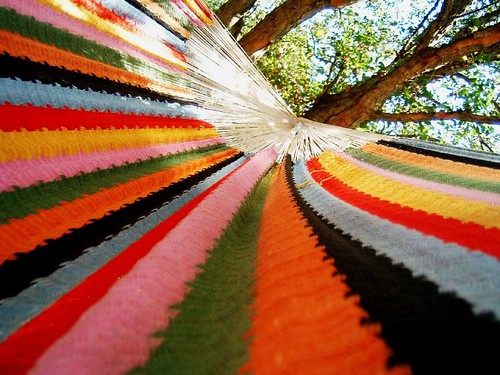We're going to buy a house and we've been looking for months and months now. One of the criteria, for me, is a yard that will welcome my hammocks. I have three: two from Brazil and one from Honduras. Sigh.... a hammock! Oh, I love laying in one and just letting go... it's one of the places where I can truly fall into relaxation.
 My Honduran hammock is similar to the one photographed here. Courtesy Tommy Images.
My Honduran hammock is similar to the one photographed here. Courtesy Tommy Images.He took this shot in Venezuela.
I thought about bringing Brazilian hammocks up to the US at one time for re-sale. But, the Brazilian ones, the ones I like, are a heavy cotton fabric. Their bulk made it prohibitive as a business for me, but there are plenty of others bringing in hammocks from all over the world. I was in Brazil about 15 years ago on a buying trip. I grew up in the South, where we did use hammocks- it's a staple piece of furniture there, but the hammock industry is based in the Northeast. On that trip, I visited villages in Recife and Bahia, primarily looking for bobbin lace and other crafts I was bringing back. Hammocks and lace production in Brazil are closely related. The word for hammock in Portuguese, rede, means net. Both are products made by fishing communities along the coast, women making lace and men making the hammocks. Unfortunately, lace-making, was disappearing as a skill even when I was last there. The women I bought from were in their 50's or older and their daughters were not following in their footsteps. A nostalgic song I grew up with, "Mulher Rendeira", talks about lacemakers who look out their windows with no future ahead. Loosely translated, the main line says, "Lace-maker woman, teach me to make lace and I'll teach you about love". Cida Moreira sings a beautiful rendition of it on her album, Na Trilha do Cinema.
Hammocks evoke images of sand, sun, beaches, warmth, vacation, sleep, lemonade, ice tea, and other pleasantries. I read up a bit on hammock history when thinking of this article and all sources I looked at credited the hammock as originating in Latin America. Christopher Columbus introduced the hammock to Europe after returning from the America's. (Wikipedia) But, when I was looking around Flickr for some beautiful photos, there were plenty of Asian ones, like this gorgeous one of a kid playing around in a hammock:
 Photo by janna, Cambodia
Photo by janna, CambodiaMy thinking is that hammocks have been used around the world, wherever there is an abundance of fiber and a weaving tradition. Hammocks are comfortable, lift you up away from dirt, wetness, bugs, and are easily portable. Sailors used them on ships.
There were several Victorian photos on Flickr that showed how a hammock might not be the best match for everyone. Lovedaylemon posted this as a found image. She states: "Found image. I can't think this lady can be very comfortable balanced on the edge of the hammock. This card was posted in Harrowgate in 1909." Photo used with her permission:

I completely agree! A hammock demands submission to its folds. There is a certain level of trust that has to happen here.
There are basically two kinds of hammocks: The most common and easily transported is an open net. My least favorite, but the most durable, are made of plastic roping. They can dig into your back. I prefer the second type of hammock, ones that are made out of woven fabric. They offer great support and comfort. The open ones can also be more dangerous, especially for little kids, as they can get tangled in them and fall off. I found a funny video on YouTube of two bears that experienced a tumble:
Animals completely understand the whole hammock concept. I saw several vendors catering to pet owners with hammocks for ferrets, cats, and other creatures. But, the most novel hammock I found was on Etsy, for $250:

Chacabraka has taken the hammock concept to an enviable level of luxury: satin and fur (is it recycled, I hope?). I can imagine this one in a cold northern land with a pot belly wood stove nearby.
Hammock production is pretty basic and can be done at home. The most challenging part is keeping all those threads in order. Documentary Educational Resources have a couple of images of how hammocks are woven in the Amazon:
 The Hammock Source has a wonderful quick video on the open weaving technique:
The Hammock Source has a wonderful quick video on the open weaving technique:Finally, Claire's Web Site offers a couple of macramé patterns for making a hammock at home.
The moral of this story is that most of us tend to go, go, go, until we drop. Why not drop into a hammock? I know I want to!






Well I certainly want one now. It would actually be perfect here...we have such a strong breeze, it would feel wonderful.
ReplyDeleteThe only problem I can think of would be the deer. I would hate for them to get tangled up in it as they roam through the yard, but I sure wouldn't want to take it down every night either.
If you put big clips on the end, you can easily leave the ends hooked together when they are not in use. That's what they do a lot in South America.
ReplyDeleteI love the Honduran hammock with that triangulated edge.
ReplyDeleteHi Rayela,
ReplyDeleteI have given you a "Sweet Home Blogger Award" over on my blog.
I will understand if you do not have time to pass this award on! None the less, I wanted to give the award to you so you knew how much I enjoyed what you do!